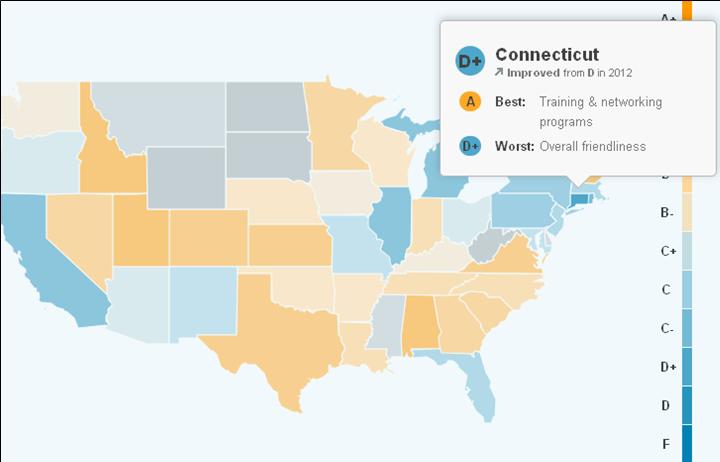CT Ranked 9th Among Small States in "Main Street Entrepreneurship," Showing Improvement
/Improvements in Connecticut’s “Main Street Entrepreneurship” has pushed the state’s ranking to 9th among the nation’s 25 smaller states, up from 12th a year ago, in the latest analysis from the Kauffman Foundation.
The nation as a whole and most states and metro areas are experiencing higher rates of small business activity, according to the 2016 Kauffman Index of Main Street Entrepreneurship. Nationally, there was a sharp uptick in the survival rate of businesses in the last year. At the same time, Main Street entrepreneurship activity gained ground in 47 states and 38 of the 40 largest metropolitan regions.
Among the nation’s smaller states, the top ranked entrepreneurial states were South Dakota, Vermont, Montana, North Dakota, Maine, Iowa, Nebraska, New Hampshire. After Connecticut, Oregon rounded out the top ten. Connecticut was one of only two states to move up three positions in the ranking.
The state’s rate of business owners was 6.55 percent; the percentage of the adult population that owns a business as their main job, according to the survey data.
The number of established (older than four years) small (less than fifty employees) businesses per 1,000 firms was 649.9 in Connecticut. In Massachusetts, which ranked third among the nation’s 25 larger states, it is 684.7. The top ranked larger states were Minnesota, Wisconsin, Massachusetts, Colorado, Pennsylvania, Maryland, Ohio, Louisiana, California and Illinois. 
"The Main Street Entrepreneurship Index provides additional evidence that U.S. small business activity has rebounded from the downturn and continues to gather strength," said Arnobio Morelix, senior research analyst at the Kauffman Foundation. "More new businesses are making it through their first five years of operation. While this could indicate that a lack of dynamism is allowing less-productive firms to hang on longer, overall the entrepreneurial increases bode well for the established, small businesses that underpin much of our economy."
Among the larger states, the rate of businesses surviving through their first five years ranges from 44 percent in Arizona to 53.3 percent in Pennsylvania. Among the smaller states, the business survival rate ranges from 43.4 percent in Nevada to 58.1 percent in North Dakota. In Connecticut, the rate is 51.35 percent, the 8th highest among the 25 smaller states.
In start-up activity, Connecticut ranked 22nd out of 25 smaller states, a drop of two positions since last year. The Survival Rate of American businesses is the main driver of the recent improvements in Main Street Entrepreneurship in the United States, and has reached a three-decade high of 48.7 percent—meaning that almost half of new businesses make it to their fifth year of operation.
U.S. Census Bureau business statistics show that established small businesses represent almost 68 percent of all employer firms in the country. The five metros with the highest Main Street entrepreneurship activity are Pittsburgh, Boston, Portland, San Francisco and Washington, D.C.
The Kauffman Index of Main Street Entrepreneurship captures business activity in all industries and is based on both a nationally representative sample size of roughly 900,000 responses each year and the universe of all employer businesses in the United States, in a dataset that covers approximately five million businesses.




 In last year’s survey, Connecticut did not receive a single grade of “F.” The state’s overall grade was D+, and included an A in training & networking, B in ease of hiring, and B- in health & safety regulations. Other grades were D+, C- and C. In the first survey conducted, in 2012, Connecticut’s overall grade was D, and the state was not graded F any category.
In last year’s survey, Connecticut did not receive a single grade of “F.” The state’s overall grade was D+, and included an A in training & networking, B in ease of hiring, and B- in health & safety regulations. Other grades were D+, C- and C. In the first survey conducted, in 2012, Connecticut’s overall grade was D, and the state was not graded F any category. wing Marion Kauffman Foundation. The
wing Marion Kauffman Foundation. The  Though they start lean, new high-tech companies grow rapidly in the early years, adding thousands of jobs along the way, according to the study findings. In fact, high-tech startup job creation is so robust that it more than makes up for the job destruction from early-stage businesses failures – a key distinction from the private sector as a whole where job losses from early-stage failures turns this group into net job destroyers, the report indicated.
Though they start lean, new high-tech companies grow rapidly in the early years, adding thousands of jobs along the way, according to the study findings. In fact, high-tech startup job creation is so robust that it more than makes up for the job destruction from early-stage businesses failures – a key distinction from the private sector as a whole where job losses from early-stage failures turns this group into net job destroyers, the report indicated. in the report, observed that “Each of the high density metro areas has one of three characteristics, and some have a combination of them all: 1) They are well-known tech hubs with highly skilled workforces, 2) They have a strong defense or aerospace presence, and 3) They are university cities.”
in the report, observed that “Each of the high density metro areas has one of three characteristics, and some have a combination of them all: 1) They are well-known tech hubs with highly skilled workforces, 2) They have a strong defense or aerospace presence, and 3) They are university cities.” this year's study.
this year's study.
 ministration reports that 69% of small businesses are at least two years old, and 51% are at least five years old. The survey sample is very close to these numbers, with 76% over two years old and 57% at least five years old.
ministration reports that 69% of small businesses are at least two years old, and 51% are at least five years old. The survey sample is very close to these numbers, with 76% over two years old and 57% at least five years old. rence of municipal leaders devoted solely to exploring entrepreneurship.
rence of municipal leaders devoted solely to exploring entrepreneurship.



























